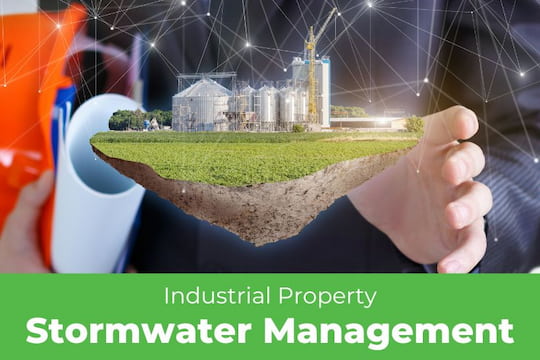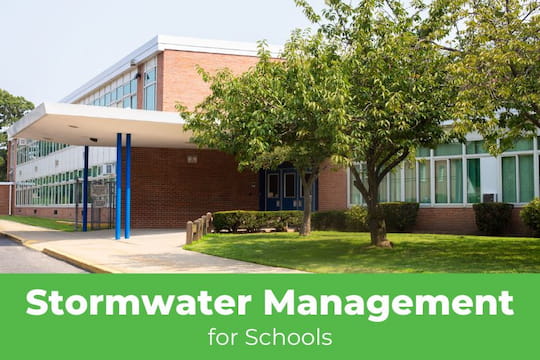Commercial properties, multifamily properties, and Homeowner Associations (HOAs) partner with vendors to manage stormwater that results from rain and snowmelt. These systems involve storm drains, gutters, detention ponds, bioswales, and other features designed to collect all the stormwater and allow it to absorb into the earth or flow out to the sea.
Reviewing the stormwater management plan is an ongoing priority. Poorly managed stormwater runoff causes damage to properties, people, and the environment. As custodians of stormwater management and the environment, property managers play an essential part in overseeing and maintaining the stormwater systems that keep the water clean and safe for aquatic life, animal life, and human life.
Stormwater Runoff Basics

As the population in Western Washington State grows, more urban development occurs. This growth brings new construction, more people, and increased stormwater runoff. Stormwater carries pollution from parking lots, public streets, and neighborhoods into Puget Sound. Most stormwater flows directly, untreated, into lakes, streams, and oceans. Polluted stormwater is a leading threat to Western Washington State’s urban streams, water areas, and animal habitats.
Soil acts as nature's filter to remove pollutants from stormwater. However, urban areas often have large amounts of pavement that doesn’t allow stormwater to permeate into the ground. Consequently, car oil, pesticides, fertilizers, piles of leaves, garbage, animal manure, and other debris pollute stormwater runoff and flow into the stormwater drainage system.
Property Plans can have several stormwater control features, such as stormwater drains, filters, bioswales, ponds, or culverts. These remove pollutants, slow down the volume of water, and allow stormwater to soak into the ground or flow through the controlled system.
Stormwater management system components do not become frequently clogged, especially provided that the client is maintaining the upstream parts of their system, such as catch basins, on a regular basis. Maintenance of upstream structures can actually greatly increase the lifespan of larger downstream structures and their components, such as filter cartridges, vaults, ponds and bioswales.
Identify Stormwater Problems on the Property

Property managers should have stormwater system plans set up and maintained by a trusted vendor. If the plans don’t exist, hire an engineer to walk the property and map out the system.
It’s fairly easy to spot some problem areas, even in dry weather. Look for stormwater drains and check that the grates are free and clear of debris. Verify that swales have been mowed, culverts kept clear of sediment and vegetation, and detention ponds maintained, free of debris and vegetation. Some areas may have invasive plants that grow very quickly and need to be cleared regularly.
After heavy rains, look for areas with pooling water. The stormwater has nowhere to go and the stormwater components are not draining properly, causing flooded areas and a serious risk to the property. Even if flood insurance covers some damage should it arise, uncontrolled flooding can cause far more damage than what’s covered under the insurance policy.
Be aware of other types of damage, such as erosion. While erosion might not seem like a big concern, eroded soil could weaken the foundation under buildings over time, causing floors to cave in and other catastrophic damage.
It is important to know about requirements to follow maintenance guidelines set by the manufacturer for any stormwater devices in their system. To stay legally compliant with state and local laws, among other reasons, adhere to a regular maintenance schedule for the stormwater management system.
Dangers of Inadequate Maintenance
Water pollution comes from many sources. Rooftops don’t get a lot of attention, but they collect a ton of leaves, branches, litter, and more. After a rain, this debris flows down to the storm drains, potentially causing them to clog up and flood areas.
Flooding can affect vehicles in underground parking lots and contaminate nearby land with polluted stormwater runoff, among other events. If flooding continues to happen, it might be years before some of the effects surface, while causing significant damage.
Untreated runoff from storms can flow into streams, lakes, and rivers, contaminating the supply of drinking water and overburdening filtration systems. Polluted runoff can harm aquatic life and create “dead zones” where no fish or other animals can survive.
Polluted water means that activities such as fishing, swimming, and boating either put people at risk of serious illness or prevent the activities altogether.
Request a Quality Stormwater Management Plan in Place

Keeping a stormwater management system in good repair protects the Sound. Effective stormwater management does not have to be complicated or expensive. Taking a proactive approach to maintaining a stormwater management system with quarterly or annual maintenance, cleaning, repairs, and yearly inspections can ensure the system is ready to accommodate whatever Mother Nature brings.
At CatchAll Environmental, we make stormwater management easier by providing proactive solutions to manage, maintain and repair stormwater systems. Our services help avoid urgent or emergency situations, which can be costly and cause further problems in the future.
Our skilled staff implements best practices for stormwater system management in our work. Don’t put your HOA, multifamily, or commercial property at risk by putting off stormwater management repairs or maintenance. Contact us in the Western Washington State area to discuss a plan for your stormwater system’s needs.













.jpg)


